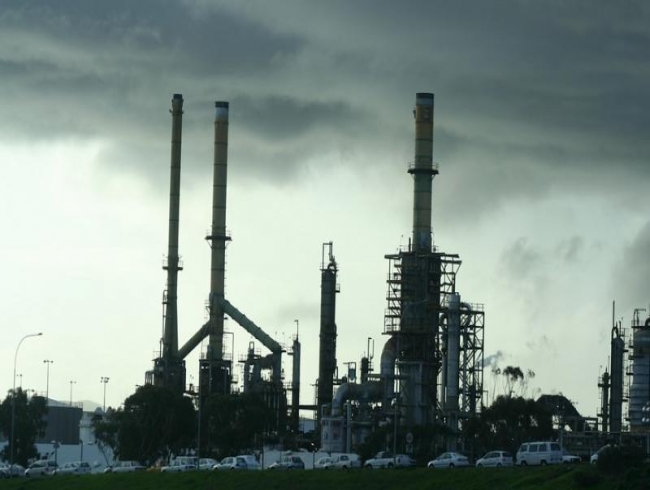Living near oil and gas facilities increases risk of diseases
Posted April 11th, 2018, 10:47 AM IST

The study, led by the Colorado School of Public Health at the University of Colorado Anschutz Medical Campus, used ambient air samples along Colorado's Northern Front Range to estimate and compare risks for four residential scenarios. Researchers found that people living the area may be exposed to hazardous air pollutants, including carcinogens like benzene, that could pose health risks.
They found the lifetime cancer risk of those living within 500 feet of a well was eight times higher than the EPA's upper level risk threshold.
"We found that air pollutant concentrations increased with proximity to an oil and gas facility, as did health risks," the study said. "Acute hazard indices for neurological, hematological and developmental health effects indicate that populations living within 152 meters (500 feet) of an oil and gas facility could experience these health effects from inhalation exposures to benzene and alkanes."
The cancer risk estimate of 8.3 per 10,000 for populations living within 500 feet of an oil and gas facility exceeded the U.S. Environmental Protection Agency's 1 in 10,000 upper threshold.
"Our results suggest that Colorado's current regulations that specify a 500 foot distance between a newly drilled oil and gas well and an existing home may not protect people from exposures to hazardous air pollutants that could impact their health," said the study's lead author Lisa McKenzie. "Our previous work shows that thousands of people along the Front Range of Colorado live closer than 500 feet from a well and related infrastructure and that the population living close to these facilities continues to grow."
The previous study examined the expansion of oil and gas wells along Colorado's Northern Front Range. In the Denver Julesburg Basin, the industry is rapidly growing along with housing construction. As a result, 19 percent of the population or about 356,000 people, live about a mile from an active oil and gas site.
The study focused on the emission of non-methane hydrocarbons (NMHCs) that the wells emit into the air. These include benzene, toluene, ethylbenzene and xylenes, all considered hazardous. "The highest concentrations of hazardous air pollutants were measured in samples collected nearest to an oil and gas facility," McKenzie said. "For example, average benzene concentrations were 41 times higher in samples collected within 500 feet of an oil and gas facility than in samples collected more than a mile away."
The researchers noted that due to high atmospheric stability, nighttime emissions do not disperse as easily as they do during the day. That means benzene levels might be twice as high at night compared to daytime levels.
"The study provides further evidence that people living close to oil and gas facilities are at the greatest risk of acute and chronic health issues due to air pollutants emitted by those facilities," said study co-author Pam Milmoe, Boulder County Public Health Air Quality Program Coordinator. "The results underscore the importance of having policies that require effective monitoring and reducing emissions from oil and gas facilities, particularly those near homes, schools, and recreation areas."
Previous studies in Colorado observed that infants with congenital heart defects and children diagnosed with leukemia are more likely to live in the densest areas of oil and gas wells. Studies in Pennsylvania and Texas found associations between fetal death, low birthweight, preterm birth, asthma, fatigue, migraines and chronic rhinosinusitis and proximity to oil and gas wells.
The study has been published in the journal Environmental Science and Technology.
- Kukatpally, Old City and Tolichowki made their mark as the city's top street food hubs
- Political leaders attend grand Alia Balai programme in Hyderabad
- Over 7,500 daily steps before surgery tied to fewer complications
- Deepika talks mental health with corporate bosses
- Sweet Shop - Owners of Calcutta and Other Ideas: Taste the universe
- Life in motion
- Witness The Most Riveting Courtroom Drama of The Year
- Mind-Body Synergy: Embracing Profound Connection Between Mental and Physical Health
- Red Haute Alert
- WWF-India Hosts Second Earth Series Talk: "A Tale of Two Cats"
- Hyderabad entrepreneurs ‘Modify’ clothes from aloe vera to orange peel
- How to Apply Onion Juice to Hair
- Patriotism is in thing, it’s Tricolour everywhere
- Celebs too wear fakes of reputed brands
- Elon Musk on fun trail says 'buying Coca Cola next'
More Lifestyle News
- ‘aha’ unveils promo for ‘Sarkaar Season 4’ featuring Sudigali Sudheer as host
- Record rains in UAE flood Dubai International Airport, disrupt travels
- Akshay Kumar joins Vishnu Manchu’s ‘Kannappa’ shoot in Hyderabad
- Suhana Khan shares joyful photos with Ananya Panday after KKR victory
- Kartik Aaryan says he’s ready for love, asks Neha Dhupia to find someone for him
- Indian film stars extend Ugadi, Gudi Padwa, and Navreh wishes
- Mrunal Thakur honored for ‘Hi Nanna’ performance, details inside
- Prithviraj-starrer ‘The Goat Life’ rakes it in: Rs 100 cr in 9 days
- Rashmika Mandanna’s ‘Srivalli’ takes center stage in Pushpa 2: The Rule poster drop
- Deepika Padukone’s ‘Deewani Mastani’ featured on Oscars’ Instagram; Ranveer Singh reacts
A PHP Error was encountered
Severity: Warning
Message: file_get_contents(): http:// wrapper is disabled in the server configuration by allow_url_fopen=0
Filename: views/newsdetails.php
Line Number: 29
Backtrace:
File: /home5/am2pm/public_html/application/views/newsdetails.php
Line: 29
Function: file_get_contents
File: /home5/am2pm/public_html/application/controllers/News.php
Line: 135
Function: view
File: /home5/am2pm/public_html/application/controllers/News.php
Line: 83
Function: newsdetails
File: /home5/am2pm/public_html/index.php
Line: 315
Function: require_once
A PHP Error was encountered
Severity: Warning
Message: file_get_contents(http://www.indiaaffiliates.in/ads.php?size=300X250): failed to open stream: no suitable wrapper could be found
Filename: views/newsdetails.php
Line Number: 29
Backtrace:
File: /home5/am2pm/public_html/application/views/newsdetails.php
Line: 29
Function: file_get_contents
File: /home5/am2pm/public_html/application/controllers/News.php
Line: 135
Function: view
File: /home5/am2pm/public_html/application/controllers/News.php
Line: 83
Function: newsdetails
File: /home5/am2pm/public_html/index.php
Line: 315
Function: require_once














